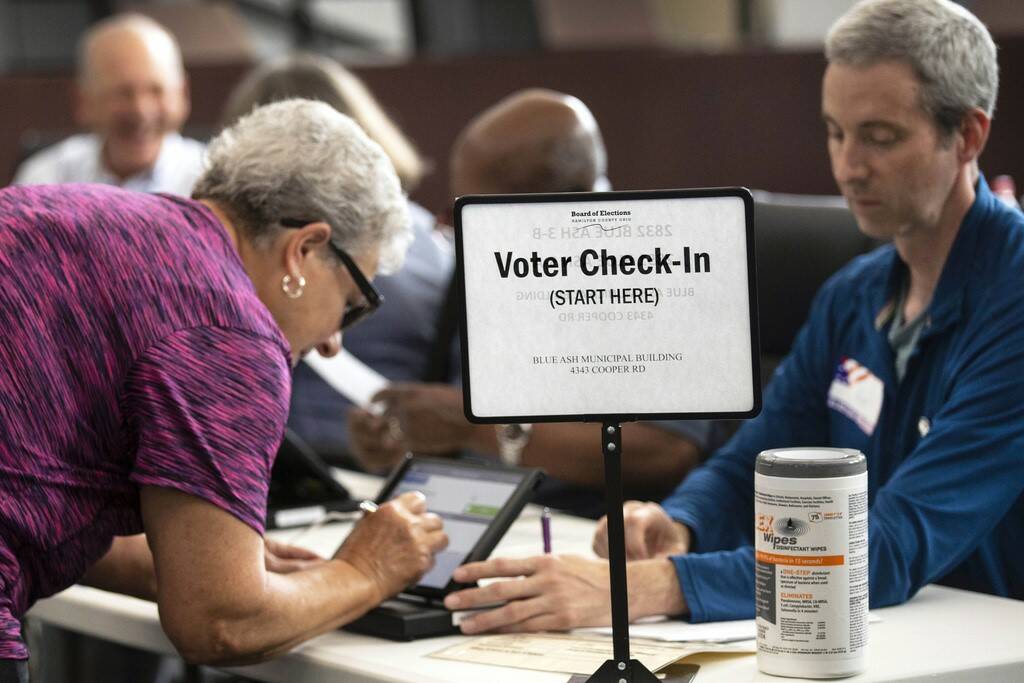
Liz Dufour | The Cincinnati Enquirer via AP, File
A poll worker prepares to give a ballot to a voter at the Blue Ash, Ohio, Municipal building for the primary elections on Aug. 2, 2022. Early voting begins Tuesday under Ohio’s sweeping new election law. For the first time this year, voters must show photo identification to vote in person, whether they’re voting early or on Election Day.
By JULIE CARR SMYTH
Associated Press
COLUMBUS, Ohio (AP) — Early voting is set to begin Tuesday under Ohio’s sweeping new election law, which includes strict photo ID requirements for voting, among other changes.
Registration for the May 2 primary closed Monday.
Here’s a look at some of the changes voters will see ahead of the May 2 primary election:
NEW ID REQUIREMENTS
Some form of photo identification will be required to cast a ballot in person, whether you’re voting early or on Election Day. This is a change from previous law, which had allowed Ohioans a variety of nonphoto options to prove their identity, including a utility bill, bank statement, government check or paycheck listing their current address.
State-issued photo IDs will be available free of charge under the new law, beginning April 7.
Acceptable forms of photo ID are:
—A state of Ohio driver’s license or state ID card, listing either your current or previous address, as long as it’s not expired; licenses from other states will not be accepted
—A military ID card, including either a U.S. military ID card, an Ohio National Guard ID card or a U.S. Department of Veterans Affairs ID card; veteran ID cards issued by county recorders will not be accepted, and military ID will no longer be accepted when registering to vote
—A U.S. passport or passport card, which is a new option this year
An exemption is provided under the law for those with religious objections to photography. You’ll be required to provide your birth date and the last four digits of your social security number on a special form.
The number from your Ohio driver’s license or state ID card, or the last four of your SSN, can be used as proof of identity when voting by mail.
The law also adds a new requirement that Ohio driver’s licenses and state ID cards indicate an individual’s citizenship status. That’s after Ohio voters last year banned noncitizen voting at the local level.
CALENDAR CHANGES
Early voting will continue through the Saturday and Sunday before Election Day, but voting on the final Monday has been eliminated. County election officials advocated for the change, which gives them more time to prepare polling places and poll workers for the final vote. The hours of voting from that Monday have be redistributed to other days within the election season.
The law also changes the window to apply to cast a mail-in ballot, to seven days before Election Day rather than three. To be counted, those ballots must arrive back at your local election board no later than four days after the election, not the 10 days allowed before. Also, you’ll have only four days after Election Day to provide missing information to “cure” a provisionally cast ballot, while previously you had seven.
PHYSICAL CHANGES
Ballot drop boxes are capped under the law at one per county, located on board of elections property. Republican Secretary of State Frank LaRose has imposed that limit by directive since 2020, despite a court ruling saying he was free to add more. The lawsuit came amid attempts by some of Ohio’s more populous counties to set up drop boxes at multiple locations throughout their areas, such as public libraries, at the height of the COVID-19 restrictions.
The new law also eliminates the curbside voting option that flourished during the pandemic, except for those whose disabilities prevent them from physically entering the polling place.
Government offices are prohibited under the law from pre-paying postage on either absentee ballot application forms or ballot return envelopes.

